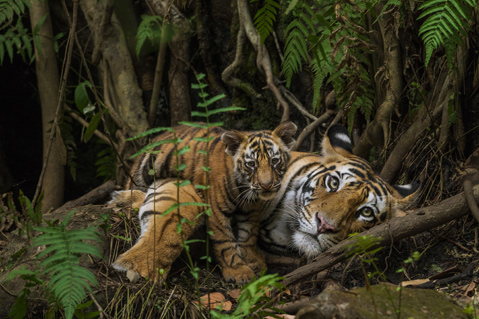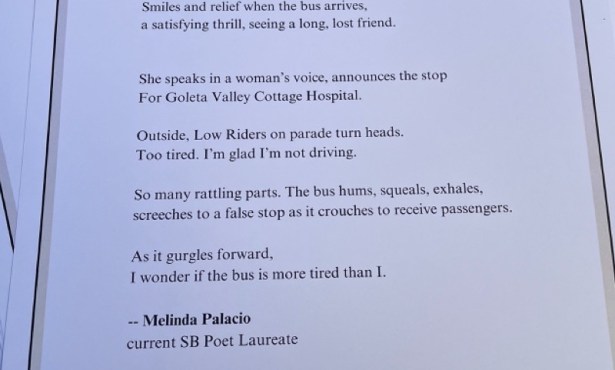Steve Winter and His Big Cats
‘National Geographic’ Photographer Comes to S.B.

“I always say, I didn’t choose the cats, big cats chose me,” offered photographer Steve Winter in a recent phone interview with The S.B. Independent. Since he was an eight-year-old boy growing up in Indiana, Winter dreamed of shooting for the iconic magazine National Geographic. His wish came true in 1991, and ever since he has been travelling the globe capturing in photos the lives of some of the world’s most illusive creatures — tigers, lions, leopards, and jaguars. In 2013, Winter and his wife collaborated on their book Tigers Forever: Saving the World’s Most Endangered Big Cat.
When not in the field, Winter traverses the world on speaking engagements to enlighten the public to the plight of the big cats, several of which are on the endangered species list. With his beautiful images in tow, Winter will visit Santa Barbara as part of UCSB’s Arts & Lectures’ Nat Geo series. Below is an abridged version of my recent conversation with the award-winning photographer.
How did you get interested in photographing big cats? I started out as a photojournalist and was at an agency in New York City. And I had been doing some work for National Geographic and got a job for [a] pharmaceuticals [company] that were, they were trying to find new drugs in the rain forest working with the Biodiversity Institute in Costa Rica. They asked me if I wanted to do this PR shoot. And I thought, public relations, I don’t really do that, but it was in Costa Rica, so I brought my family and went down there … That was the first time I was ever in a jungle. And one of the scientists I worked with [there] said, “I have a story for you” and he sent me the information and it was in Guatemala…I was doing my first bird story for National Geographic on a bird, the Quetzal, the sacred bird of the Mayans, and I was on top of a mountain in a cloud forest in Guatemala, and one night I was in my bunk, reading my book like I always do to go to sleep, and I heard the creaking, like somebody walking up the stairs and then it stopped on the porch. Then I heard scratching under the door and then sniffing. Now, that scared me to death…and I called on the walkie-talkie and told Juan Carlos, the guy I was with, what happened and he just started laughing and said not to worry, that it was just a black jaguar. …I knew something was [around] because I’d walk back at the end of the day, and my hair on my arms and the back of my head would stand up — it’s like our brains are hardwired still [with] primordial instincts. That cat was following me…These cats are curious, they wanna know who you are, they don’t attack you, but you’re a guest in their home, which is the forest.
So you went for a story of a bird, and you came back with the big cat bug. Yeah. It took me organizing this presentation to realize really that that was the moment that it all happened…. I [then] saw a story about a cowboy in Arizona, who took the first picture of a jaguar in the United States. I went to Arizona and worked with the cowboy who had taken that first picture of a jaguar in the United States….Finally, I ended up in Brazil working at the place where now you can go see jaguars [the Jaguar Ecological Reserve].
There aren’t usually jaguars in the United States, are there? Yeah, I just got off the phone with the University of Arizona researchers who are putting up remote cameras and for the last three years they’ve been photographing a jaguar in Arizona….There’s a big jaguar corridor, from Arizona to northern Argentina.
Do you have a favorite big cat? I have a soft spot for snow leopards, but I spent over a decade working with tigers, and with my wife I did the National Geographic tiger book called Tigers Forever.…I don’t have a favorite cat or a favorite family member, but I do love tigers…[All the big cats] are vitally important to us as human beings; one of their favorite habitats are the forests of the world, whether it’s the Amazon for jaguars and pumas or central Africa for lions and leopards, and the grasslands, and then the forests of south Asia for tigers and leopards…The homes of these big cats, which are the top predators…if you save the top predator in any ecosystem, you save everything underneath them.
So to save the big cats, we have to let forests regrow, but isn’t part of the problem that there’s not even space? Well, there is space, we just are removing these forests, but not for many intelligent reasons. When I was in Sumatra you could drive for a long way seeing forests that were recently cleared for palm oil, but they never re-planted the palm oil tree, they just cut the forest and sold the logs….There [would] not be a lot of reason for these forests to be cut if we had land usage and management done intelligently. In the Amazon, they [clear cut] because of slash and burn…but it’s not good for growing any crops, like five years at the most, and then they have to cut down more forest. And the Amazon is vitally important. They’re having major drought in the south of Brazil because they have had all this deforestation going on for so many decades there now. And all of a sudden Brazil is waking up to the fact that São Paulo doesn’t have water. Well, the whole weather system is created by the Amazon rain forest. And deforestation amounts to all the carbon output by transportation, every bit of transportation combined, every year, just the amount of trees that are cut down. So that means all the cars, all the airplanes, all the trains…We need to find a new way to do this, because nobody wants to walk around with a oxygen tank on their back.
Since you’ve been following the big cats, have you seen any change for the better in terms of their legacy? Yeah, there are many positive things that are going on. Even though, like anything in life, you almost have to see really bad things happen before we wake up to change. Cecil the Lion really helped people look at lions again. And if he hadn’t had a name that would never have happened. But we’re losing so many lions. Not from specifically big game hunting, but from habitat loss, and certain types of hunting. But primarily habitat loss. Tigers, they’re being stabilized in some ways, and I think organizations, like WildAid in San Francisco, are vitally important because they look at the usage of a species, whether it’s ivory, rhino horn, or tiger bone, saying if you stop the demand the killing can too, because you can’t just ring every park with police, it’s not realistic. But you stop the demand with the young people, in the countries that are using something as ridiculous as rhino horn, which is made out of keratin, the same thing as our hair and our fingernails. I always said, “Chew your fingernails and save a rhino.”
What WildAid’s done is amazing. The first time I [heard of them] was the WildAid National Geographic movie with Jackie Chan saying that “When I was a young martial artist, they gave me tiger bone, it did nothing. They gave me rhino horn, it did nothing.” They’re using people like Yao Ming, who used to play for the Houston Rockets, and a bunch of pop and movie stars in China to give public service announcement to try to stop the ivory trade, and rhino horn and tiger bone and shark fin. Yao Ming [spoke about] shark fin and its usage dropped by a huge percentage, like 60 percent in three years.
Which country do you think is the best and the worst? God, I couldn’t even say, because good things are happening everywhere.
Well, that’s encouraging. In South Africa, where they have canned hunting [where the animals are kept in a fenced in area] a film came out called Canned Lions, and because of this, many hunting outfitters are stopping using lions that were just born to hunt. They’re stopping it, so that’s great! So land in South Africa that was put aside for hunting concessions — there’s three times more land for hunting in South Africa than for national parks — [is now] land protected…I’m not saying things are great by any means, but they’re moving in a positive direction.
And what about the mountain lion, the cougars — we get a lot of those in the hills here in Santa Barbara. Yeah. I took the picture of the mountain lion under the Hollywood sign. So that was probably one of my most successful images because of the wildlife overpass that they want to put there on the 101 by Liberty Canyon….It’s amazing that we do live with mountain lions but we don’t know it…If a cat is really hungry it’s going to come around people. [But] this whole idea of man-eaters really comes from a couple historic situations, like the lions of Tsavo, when the British were building a railway in Africa. That was like two lions that created a book, movies, and this whole thing of man-eaters.
Well, you know, I don’t blame those big cats. We’ve been killing them for a long time. I always thought it was pretty cheeky for the top predator on the planet to be saying that all these predators want to kill us. [The cougar] in L.A. is a perfect example. He lives in eight square miles, and until he got stuck in that crawl space there were only three people that had seen that cat — that’s one person a year. Eight square miles down in L.A.! How many millions of people visit Griffith Park every year and they never saw that cat?
There is a mythology that’s formed around tigers and other big cats that they are devil creatures. Well, nobody would’ve gone to see Jaws if it didn’t kill people. That’s one way to look at it. [Laughs]
So people like you are trying to undo all the things that other people have done. Well, we’re trying and I just give my life as a National Geographic photographer working with big cats. I’m due in Kansas City next week [for a talk] and it’s in a huge venue…and I just found out there are only a few tickets left. I did Spokane last week and it was sold out. I sold out the Sydney Opera House [talking about big cats]….I always say I’m one of the luckiest guys on the face of the earth, cuz I wanted to be a National Geographic photographer since I was eight years old. So I’m living my dream.
4•1•1
UCSB’s Arts & Lectures presents Nat Geo’s Steve Winter who will present “On the Trail of Big Cats: Tigers, Cougars, and Snow Leopards” Sunday, March 6, 3 p.m., UCSB’s Campbell Hall. For tickets and information, call (805) 893-3535 or see artsandlectures.sa.ucsb.edu.



